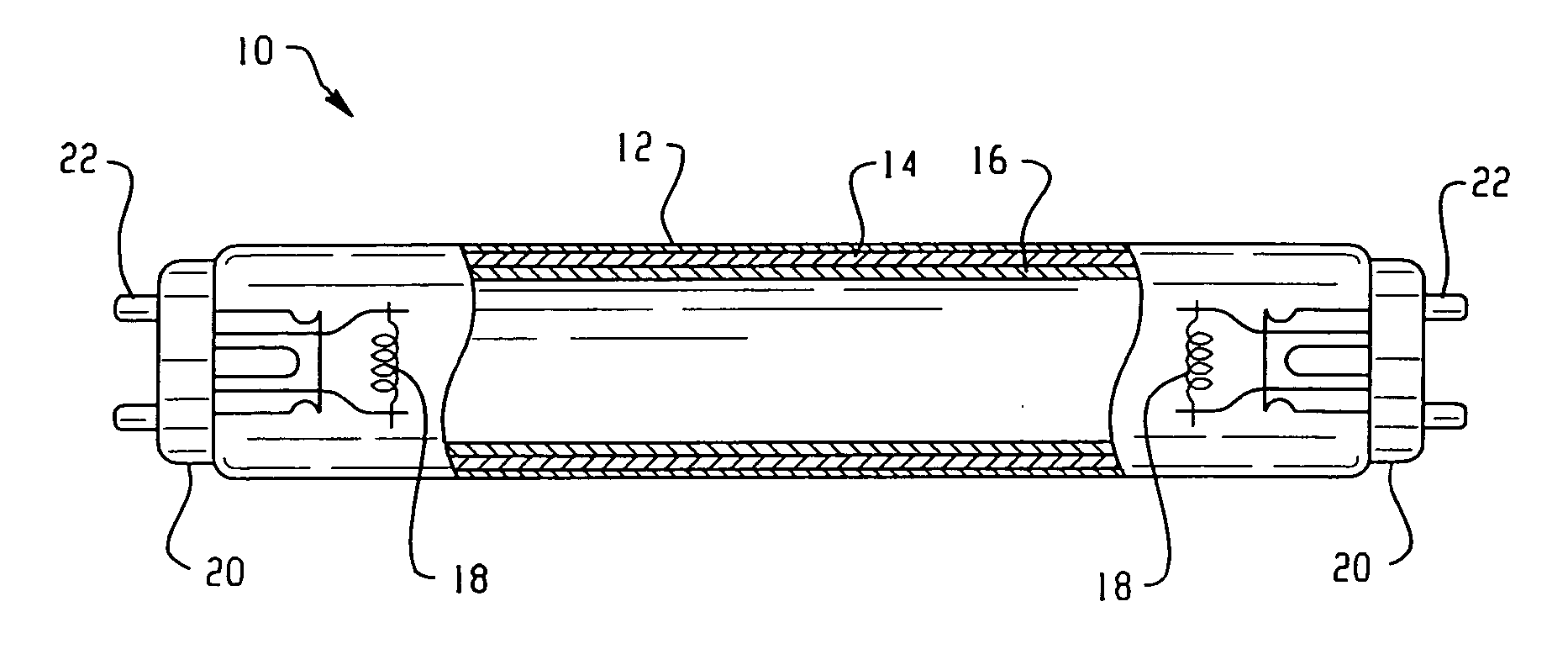Optimized phosphor system for improved efficacy lighting sources
a phosphor system and lighting source technology, applied in the direction of discharge tube/lamp details, discharge tube luminescnet screen, gas-filled discharge tube, etc., can solve the problem of degrading the color rendering properties of the lamp, the efficacy of such tri-phosphor lamps is less than, and the object whose colors lie between the spectral peak is not as good as the object, so as to improve the luminosity and improve the effect of luminosity
- Summary
- Abstract
- Description
- Claims
- Application Information
AI Technical Summary
Benefits of technology
Problems solved by technology
Method used
Image
Examples
example 1
[0073] A lamp having a CRI of 75 may be prepared using a phosphor blend comprising BaMgAl10O17:Eu2+, Zn2SiO4:Ge4+,Mn2+, (Y,In)BO3:Eu3+, and Y2O3:Eu2+. The resulting emission spectra of the blend is shown in FIG. 2. The resulting lamp had a calculated luminosity at 4100 K that was 2.6% greater than a lamp having a CRI of 83 prepared using a known tri-phosphor blend comprising BaMgAl10O17:Eu2+, LaPO4:Ce3+,Tb3+, and Y2O3:Eu3+.
example 2
[0074] A lamp having a CRI of 82.5 may be prepared using a phosphor blend comprising BaMgAl10O17:Eu2+, Zn2SiO4:Ge4+,Mn2+, and Y2O3:Eu2+. The resulting emission spectra of the blend is shown in FIG. 3. The resulting lamp had a calculated luminosity at 4100 K that was 1.8% greater than a lamp having a CRI of 83 prepared using a known tri-phosphor blend comprising BaMgAl10O17:Eu2+, LaPO4:Ce3+,Tb3+, and Y2O3:Eu3+.
example 3
[0075] A lamp having a CRI of 87 may be prepared using a phosphor blend comprising BaMgAl10O17:Eu2+, Zn2SiO4:Ge4+, Mn2+, Y2O3:Eu2+, and BaMgAl10O17:Eu2+,Mn2+. The resulting emission spectra of the blend is shown in FIG. 4. The resulting lamp had a calculated luminosity at 4100 K that was 1.7% lower than a lamp having a CRI of 83 prepared using a known tri-phosphor blend comprising BaMgAl10O17:Eu2+, LaPO4:Ce3+,Tb3+, and Y2O3:Eu3+. It is well known that at higher CRI values, there is an inherent tradeoff between luminosity and CRI. Thus, although the lamp having a CRI of 87 has a slightly lower lumen output compared to the known tri-phosphor lamp, it has a higher CRI and the reduced luminosity is actually superior to other known lamps having such a high CRI.
PUM
 Login to View More
Login to View More Abstract
Description
Claims
Application Information
 Login to View More
Login to View More - R&D
- Intellectual Property
- Life Sciences
- Materials
- Tech Scout
- Unparalleled Data Quality
- Higher Quality Content
- 60% Fewer Hallucinations
Browse by: Latest US Patents, China's latest patents, Technical Efficacy Thesaurus, Application Domain, Technology Topic, Popular Technical Reports.
© 2025 PatSnap. All rights reserved.Legal|Privacy policy|Modern Slavery Act Transparency Statement|Sitemap|About US| Contact US: help@patsnap.com



